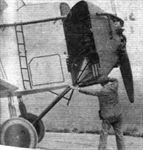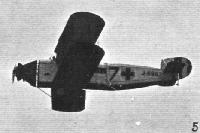
Bristol Type 62 Ten-Seater
Самолет Bristol Type 62 Ten-Seater, появившийся на свет благодаря решению британского Казначейства субсидировать создание ряда авиакомпаний, первоначально предполагалось оснастить радиальным мотором Bristol Jupiter. Машина была рассчитана на перевозку шести пассажиров, но в начале 1921 года, когда стал доступен двигатель Napier Lion мощностью 450 л. с. (336 кВт), размеры самолета несколько увеличили, доведя его вместимость до одного пилота и девяти пассажиров. Первая машина поднялась в воздух 21 июня 1921 года. По результатам заводских испытаний сделали только одну крупную доработку - сняли переднюю пару стоек шасси. После прибытия в Кройдон 8 июля 1921 года самолет совершил несколько экспериментальных рейсов и в следующем месяце был передан в испытательный центр А&АЕЕ в Мартлешем Хит. В декабре самолет был приобретен Высшим советом по делам авиации и позднее передан авиакомпании "Instone Air Line" для эксплуатации на линии Лондон - Париж. Затем машина использовалась авиакомпанией "Handley Page Transport Ltd".
Варианты
Type 75: двигатель Jupiter, прошедший сертификацию в сентябре 1921 года, в виде легкодоступной для обслуживания силовой установки (т. н. "power egg") был установлен на втором экземпляре Ten-Seater, получившем обозначение Type 75. Машина, совершившая первый полет в июне 1922 года, в феврале 1924 года была куплена авиакомпанией "Instone Air Line" вместе с недостроенным четвертым самолетом, служившим источником запасных частей. Когда "Instone" вошла в состав "Imperial Airways", использовавшей для пассажирских перевозок только многомоторные самолеты, Type 75 стали использовать для перевозки грузов. После доработки с 22 июля 1924 года самолет стал выполнять рейсы на линии Лондон-Кёльн под обозначением Type 75А Express Freight Carrier; эксплуатация завершилась в 1926 году
Type 79 Brandon: третий самолет, также оснащенный двигателем Jupiter, после ряда доработок, в том числе сокращения размаха крыльев, был превращен в транспортный вариант для перевозки военнослужащих или раненых. В салоне могли размещаться две пары носилок и четыре сидячих пациента или три пары носилок и сопровождающий медик.
ТАКТИКО-ТЕХНИЧЕСКИЕ ХАРАКТЕРИСТИКИ
Bristol Type 75
Тип: транспортный самолет
Силовая установка: один радиальный двигатель Bristol Jupiter мощностью 425 л.с (317 кВт)
Летные характеристики: максимальная скорость 177 км/ч на оптимальной высоте; потолок 2590 м; продолжительность полета 5 ч 30 мин
Масса: пустого 1814 кг; максимальная взлетная 3064 кг
Размеры: размах крыла 17,07 м; длина 12,34 м; высота 3,35 м; площадь крыла 65,03 мг
Описание:
- Bristol Type 62 Ten-Seater
- Flight, July 1921
THE BRISTOL COMMERCIAL TEN-SEATER BIPLANE - Flight, January 1922
THE "BRISTOL" 10-SEATER
Фотографии
-
Мировая Авиация 75
Регистрационный номер: G-EAWY [8] Первоначально Type 62 имел две пары расположенных тандемно основных стоек шасси, причем тормозами были оснащены только колеса задней пары.
-
Aeroplane Monthly 1990-11 / J.Stroud - Wings of Peace
Регистрационный номер: G-EAWY [8] The first Ten-seater (Type 62) as originally built with four-wheeled undercarriage. It was equipped for night-flying.
-
Flight 1921-11 / Flight
Регистрационный номер: G-EAWY [8] The Bristol 10-seater commercial biplane, fitted with a Napier "Lion."
-
Flight 1922-02 / Flight
Регистрационный номер: G-EAWY [8] The Bristol 10-Seater. Inset, the machine in flight.
-
Aeroplane Monthly 1990-11 / J.Stroud - Wings of Peace
Регистрационный номер: G-EAWY [8] The Type 62 Ten-seater with two-wheel undercarriage and horn-balanced rudder.
-
Flight 1921-07 / Flight
Регистрационный номер: G-EAWY [8] BRISTOL TEN-SEATER. The Bristol Type 62 Ten-Seater first flew on 18th January 1924. A successor to the Type 26 Pullman triplane of 1920, the 450-h.p. Napier Lion, Srs. II-powered Type 62 in turn gave way to the Types 75 and 75A, Ten-Seater and Express Freighter - both being powered by 425-h.p. Bristol Jupiter IV radials. In the Type 62, the pilot and mechanic sat side-by-side in an open cockpit forward of the upper mainplane. With a span of 54 ft., and length of 42 ft., the Type 62 Ten-Seater possessed a maximum speed of 122 m.p.h. for an a.u.w. of 8,800 lb. It was later used on European services undertaken by Handley Page Transport Ltd.
-
Flight 1922-01 / Flight
Регистрационный номер: G-EAWY [8] THE BRISTOL 10-SEATER, WITH "JUPITER" ENGINE: The new Bristol standard swivelling mounting is incorporated in this machine, and greatly facilitates inspection and minor adjustments.
-
Aeroplane Monthly 1974-01 / P.Moss - Wings for the Empire (1)
Регистрационный номер: G-EBEV [5] King's Cup machines. (2) Bristol 10-seater (400 Bristol "Jupiter")
Bristol 75 Ten-seater before modification for Instone use. -
Aeroplane Monthly 1990-11 / J.Stroud - Wings of Peace
Регистрационный номер: G-EBEV [5] The Type 75 Ten-seater as a passenger aeroplane.
-
Flight 1931-10 / Flight
Регистрационный номер: G-EBEV [5] The "Bristol" 10-seater, with Bristol "Jupiter" engine.
-
Flight 1922-09 / Flight
Регистрационный номер: G-EBEV [5] The Bristol 10-seater, 400 h.p. Bristol "Jupiter."
-
Flight 1939-03 / Flight
The swinging engine mounting used in this and other Bristol machines of the same period.
-
Aeroplane Monthly 1990-11 / J.Stroud - Wings of Peace
Регистрационный номер: G-EBEV [5] The Type 75 after being modified to Type 75A freighter.
-
Flight 1923-02 / Flight
The New "Jupiter" Cowling on the Bristol Pullman biplane: Inset the Pullman in flight, carrying a number of visitors.
-
Flight 1922-02 / Flight
FROM THE AIR CONFERENCE VISIT TO WADDON: The photograph gives a good idea of the different types of machines on view. Vickers "Vimys," "D.H." monoplane, and several types of "D.H." biplanes, Bristol Ten-seater, Farman Goliaths, etc.
Другие самолёты на фотографии: De Havilland Doncaster / D.H.29 - Великобритания - 1921Farman F.60 Goliath / F.169 - Франция - 1918Vickers Vimy Commercial - Великобритания - 1919
-
Flight 1940-02 / Flight
The Brandon biplane was probably the first British military ambulance aeroplane. 1923
-
Flight 1925-06 / Flight
Регистрационный номер: J6997 [3] AT THE R.A.F. DISPLAY: The Bristol "Brandon" Ambulance (400 h.p. Bristol "Jupiter").
-
Flight 1924-04 / Flight
Регистрационный номер: J6997 [3] A BRISTOL "AMBULANCE" AEROPLANE: Our photographs show the new Bristol specially arranged for Red Cross work. The large cabin, white enamelled throughout, measures 10 ft. 6 ins. in length, and is 5 ft. 9 ins. high and 4 ft. wide. The large windows can be opened along the entire length of both sides so as to give ample ventilation even in hot climates. Two stretcher cases and four sitting cases can be carried, or the accommodation can be varied to allow of three of the passengers being accommodated on stretchers. A wide entrance has been made in the port side, opposite the main entrance door, which is on the starboard. The engine fitted is a Bristol "Jupiter" of 400 h.p.
-
Flight 1925-07 / Flight
Регистрационный номер: J6997 [3] "NEW AND EXPERIMENTAL": Some of the machines which took part in the "Fly Past" at the R.A.F. Display. (5) Bristol "Brandon" (400 h.p. Bristol "Jupiter"), an ambulance 'plane.
-
Aeroplane Monthly 1990-11 / J.Stroud - Wings of Peace
The cabin of the first Bristol Ten-seater.
-
Flight 1921-11 / Flight
The Cabin of the "Bristol" Ten-Seater: Although not including all the seats, this photograph gives an excellent idea of the roominess of the cabin and of the good view obtained through its windows. The machine, which has a 450 h.p. Napier "Lion" engine, was fully described in our issue of July 7, 1921.
-
Aeroplane Monthly 1990-11 / J.Stroud - Wings of Peace
Регистрационный номер: G-EAWY [8] Although never used by Imperial Airways, the Bristol Type 62 Ten-seater is shown in KEITH WOODCOCK'S painting as it appeared at the 1925 British Empire Exhibition at Wembley.
-
Flight 1921-07 / Flight
Bristol Commercial Ten-seater 450 H.P. Napier "Lion" Engine
- Фотографии






















